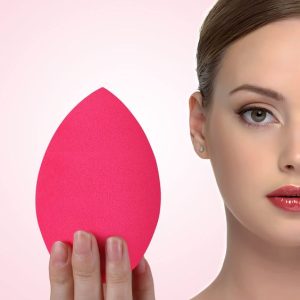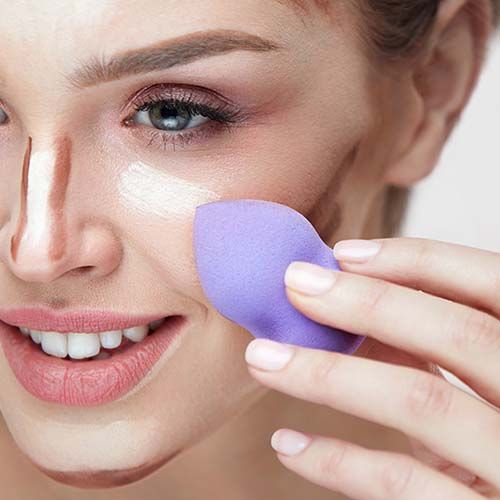How to Clean Makeup Sponges
To clean makeup sponges, start by rinsing them under lukewarm water to remove any excess makeup. Then, apply a small amount of gentle soap or cleanser directly onto the sponge. Gently massage the soap into the sponge and work it into a lather. Rinse the sponge thoroughly until the water runs clear, squeezing out any remaining soap.
If needed, repeat the process until the sponge is clean. Finally, squeeze out any excess water and allow the sponge to air dry completely before using it again. It’s essential to clean makeup sponges regularly to prevent bacteria buildup and maintain their effectiveness.
Understanding Your Makeup Sponge

Before delving into the cleaning process, it’s crucial to understand the type of makeup sponge you’re using. There are various types available, including latex, non-latex, and silicone sponges. Each type has its own characteristics and requires specific cleaning methods. Additionally, makeup sponges tend to absorb makeup products and oils, making them a breeding ground for bacteria over time.
Frequency of Cleaning
Ideally, makeup sponges should be cleaned after each use to prevent bacteria buildup and ensure optimal performance. However, if you’re unable to clean them daily, aim for at least once a week. Signs that your sponge needs cleaning include a visibly dirty appearance, unpleasant odor, or changes in texture.
Materials Needed
To clean your makeup sponge effectively, you’ll need a gentle cleansing agent such as mild soap, baby shampoo, or specialized sponge cleanser. Additionally, gather some lukewarm water and a clean towel or paper towels for drying.
Methods of Cleaning
There are several methods for cleaning makeup sponges, each with its own benefits. The most common methods include handwashing, machine washing, and the microwave method. Read More Articles visit our site: urbanglamz.com
Step-by-Step Guide
Handwashing Technique:
- Wet the sponge with lukewarm water.
- Apply a small amount of gentle cleanser to the sponge.
- Gently massage the sponge to lather and remove makeup residue.
- Rinse the sponge thoroughly under running water until the water runs clear.
- Squeeze out excess water and repeat if necessary.
- Allow the sponge to air dry completely before using it again.
Machine Washing:
- Place the makeup sponge in a mesh laundry bag to protect it.
- Add a small amount of mild detergent to the washing machine.
- Wash the sponge on a gentle cycle with lukewarm water.
- Once the cycle is complete, remove the sponge from the bag and rinse thoroughly.
- Squeeze out excess water and air dry.
Microwave Method:
- Dampen the sponge and place it in a microwave-safe bowl filled with water.
- Add a few drops of gentle soap or cleanser to the water.
- Microwave the sponge on high for 1-2 minutes to kill bacteria.
- Carefully remove the sponge from the microwave and allow it to cool.
- Rinse the sponge thoroughly and squeeze out excess water before drying.

Drying Your Sponge
Proper drying is essential to prevent mold and bacteria growth. After cleaning, always allow your sponge to air dry completely in a well-ventilated area. Avoid towel-drying, as this can transfer bacteria and lint to the sponge.
Storage Tips
To keep your makeup sponge clean between uses, store it in a clean, dry place away from moisture and direct sunlight. Avoid storing damp sponges in a closed container, as this can promote bacterial growth.
Deep Cleaning Techniques
For a more thorough clean, consider deep cleaning your makeup sponge once a month. Two effective methods are soaking the sponge in a vinegar solution or a diluted bleach solution. However, be sure to rinse the sponge thoroughly after using these methods to remove any residual chemicals.
Maintaining Sponge Longevity
To prolong the lifespan of your makeup sponge, handle it with care and avoid tearing or stretching it during use. Additionally, regularly clean and replace your sponge as needed to ensure optimal performance and hygiene.
Alternative Cleaning Methods
If you run out of specialized sponge cleanser, you can use gentle brush cleansers or even make your own DIY cleaning solution using household ingredients like olive oil and dish soap. However, avoid using harsh chemicals that can damage the sponge or irritate your skin.
Common Mistakes to Avoid
When cleaning your makeup sponge, avoid using harsh chemicals or abrasive cleaners that can damage the sponge’s texture. Additionally, ensure thorough drying to prevent mold and mildew growth. Always follow the recommended cleaning instructions for your specific type of sponge.
Environmental Considerations
For those concerned about environmental impact, there are eco-friendly cleaning options available, such as solid brush cleansers and biodegradable sponge cleansers. When it’s time to replace your old sponge, consider recycling or composting it if possible.
Conclusion
Regularly cleaning your makeup sponge is essential for maintaining good hygiene and achieving flawless makeup application. By following these simple steps and methods, you can ensure that your makeup sponge remains clean, bacteria-free, and ready for use.
FAQs
- What happens if I don’t clean my makeup sponge regularly? Neglecting to clean your makeup sponge can lead to bacteria buildup, which can cause breakouts and skin irritation.
- Can I use regular soap to clean my makeup sponge? While regular soap can be effective, it’s best to use a gentle cleanser specifically formulated for makeup sponges to avoid damaging the material.
- How often should I replace my makeup sponge? It’s recommended to replace your makeup sponge every 3-4 months or sooner if it shows signs of wear or begins to deteriorate.
- Is it safe to use the microwave method to clean makeup sponges? Yes, the microwave method can effectively kill bacteria on makeup sponges, but be cautious not to overheat the sponge to prevent damage.
- Can I clean my makeup sponge with just water? While water alone can help rinse out some makeup residue, it’s best to use a cleansing agent to thoroughly remove dirt and bacteria.

